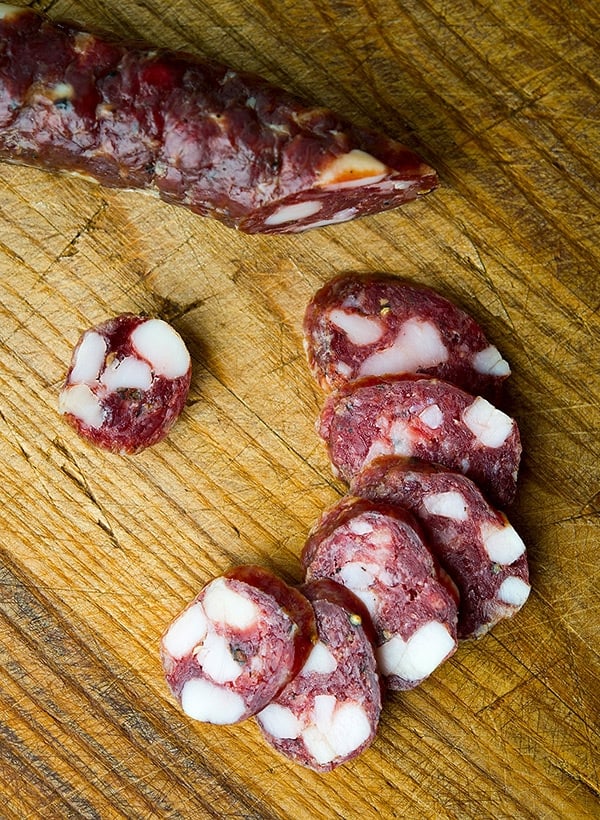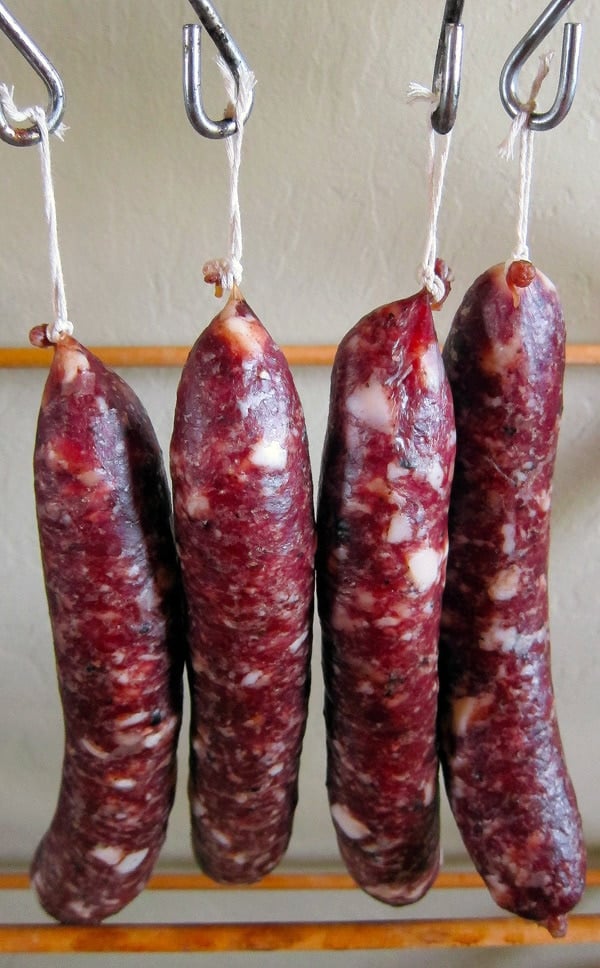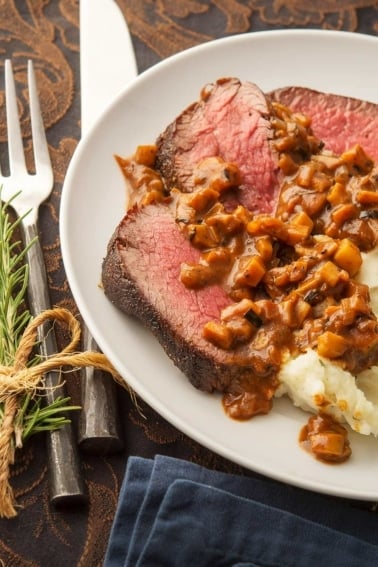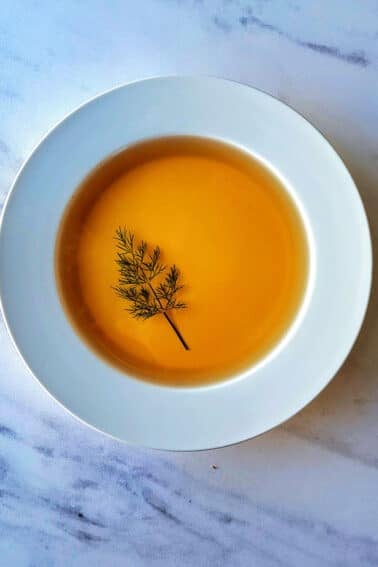As an Amazon Associate I earn from qualifying purchases.

With the possible exception of a whole dry-aged ham, to my mind salami is the highest form of the butcher’s art.
The careful crafting of raw meat, salt, spices and time create something very different from a fresh sausage. It is not crazy to call it alchemy. But making salami is no joke. It takes time, an attention to detail (and sanitation), plus a careful eye to troubleshoot problems. Doing this at home is not for beginners.
But when you do pluck up enough courage to make your own at home, this is the salami recipe you should start with. It is the classic, the “little black dress” of a salami, flavored only with salt, black pepper and a bit of garlic. The meat is the star here, not the spices.
Every salami-making culture makes a version of this sausage, and recipes are similar whether you look to Spain or France or Italy or Hungary or Germany — although these last two nations tend to smoke their salami, too.
If you’ve never made fresh sausages before, bookmark this recipe and come back when you’ve made a dozen or so batches. You need to be comfortable with the basic sausage-making process before you take the step of curing them. You also need some special equipment. Don’t try to shortcut salami making. You will pay for it eventually.
First, you need a good grinder. For small batches I use the KitchenAid grinder attachment, but with anything larger than 5 pounds, I use a Weston grinder. You need a sausage stuffer, too. Can you hand-cut the meat and fat? Yes, but it requires a sharp knife and an awful lot of patience.

To hang your sausages for the few days it takes to ferment them, I use a simple wooden clothes rack. I also buy “S” hooks from the local hardware store to hang the links. You’ll also need a humidifier both for the fermentation process and while your links are drying. I use this one , and it’s worked well for me for 3 years now.
Finally, you must have a curing chamber; my friends at Elevated Wild have a DIY tutorial here, and I use a fancy Dry Ager, which ain’t cheap, but it’s great.
The salami-making process is this: You make sausage, only with added sodium nitrate (Instacure No. 2) and a starter culture, then ferment the sausages at room temperature for a few days to let the good bacteria in the starter beat back any bad bugs within the meat. Do you need these? Absolutely.
Yeah, I hear you: “But can’t salami be made without them?” Yes. But you can’t. The people who can work in places where they’ve made salami for decades or even centuries, and the ambient air has the good bacteria already; it’s like a sourdough. For you and me, nitrate and starter culture is an insurance policy against botulism and listeria.
The last stage is to hang the links to dry out slowly in the chamber or in a basement.
The key to successful drying is to let the sausages dry slowly, little by little. Why? This does two things: First, you prevent the dreaded “case hardening,” where the outside of the salami dries too fast and prevents the interior from drying properly. And second, the longer you cure your salami, the better it will taste.
Truly great salami has a distinct funk to it, like cheese. I’ve made a lot of decent salami, some mediocre and a few crappy ones. Only once in a while does everything work perfectly. The batch of wild boar salami in these photos was one such time. I cured these links for more than 2 months, with slowly decreasing humidity until they had that sweetish meat funk we all know and love.
Don’t know what I am talking about? That’s because 90 percent of all salami made in the United States is not cured long enough. It’s fine, but hasn’t had the time to develop. We Americans are always in a hurry.
Follow this recipe, get decent equipment, and you should be fine. But remember: Sausage making is a sprint, salami making is a marathon. You must be careful and clean at the start — remember we’re dealing with raw pork here — and you cannot forget about your salami while it cures or you may be very, very sad. Still, this ain’t rocket science.
You can make salami at home, and when you do, it is one of the most satisfying things you can make with your own two hands.
This is my master recipe for making salami. It works well with most meats, and over the years I’ve done it with pork, wild boar, venison, duck, goose, bear and lamb. The fat is always pork fat, with rare exceptions.
If you have something against pork, use the fat trimmed from lamb or beef steaks and roasts, not suet or kidney fat, which is too waxy.
There is no substituting the Instacure No. 2 in this recipe. Nitrate has been used in salami making for 2000 years, and I don’t intend to break that tradition. And for those of you freaked out by nitrates, know that a serving of spinach or celery will give you 100 times more nitrates than you will get by eating this salami.

As for the starter culture, I know it’s a lot. Technically you could cut the amount of culture a a few grams, but you’d need to make sure the meat is really well mixed to get it distributed right. The amount I use is essentially the “better safe than sorry” approach. If you want to use less, that’s on you.
Finally, I prefer using really wide hog casings instead of beef middles, as is customary in Italy. Why? They’re easier to cure, and are still plenty wide enough to get a nice slice.
I get my wide hog casings, starter culture and Instacure all online from Butcher and Packer.
Basic Salami
Ingredients
- 4 pounds pork shoulder or wild boar meat
- 1 pound pork fatback
- 51 grams salt
- 6 grams Instacure No. 2
- 12 grams sugar or dextrose
- 1 tablespoon coarsely ground black pepper
- 2 tablespoons minced fresh garlic
- 1/3 cup red wine
- 1/4 cup distilled water
- 5 grams FRM-52 starter culture, or T-SPX culture
- Hog casings, preferably 38-42 mm wide casings
Instructions
- Start by setting out 1/2 to 2/3 pound of the pork and dicing it fine. I like doing this because it varies the grind within the sausage from very fine to chunky. To me, this is more interesting. You can run it all through the grinder if you prefer, or if you think someone will get all crazy if they see big pieces of fat in their salami. Cut the remaining fat and meat into chunks that will fit into your grinder. Trim as much sinew and silverskin as you can.
- Put both the diced and chunked fat into separate containers in the fridge. Mix the salt with the meat and put it in the fridge overnight. This helps develop myosin, which will give you a tighter bind when you stuff the links later.
- The next day, put the fat and your grinding equipment -- blade, coarse and fine die, etc -- in the freezer. Mix the Instacure, garlic and half the black pepper into the meat. Put that in the freezer, too. Let everything chill down until the meat hits about 28°F or so. It won't freeze solid because of the salt. Normally this takes about 90 minutes. While you're waiting, soak about 15 feet of hog casings in a bowl of warm water, and put the red wine in the fridge.
- When the meat and fat are cold, take them out and mix together, but keep the diced fat separate for now. Grind 1/2 to 2/3 of the mixture through the coarse die of the grinder. Grind the rest through the fine die. I do this to vary my grind, which makes for a better texture in my opinion. Sometimes I do 3/4 fine and 1/4 coarse, depending on my mood. The key is variability.
- Put the meat and fat back in the freezer while you clean up. Dissolve the starter culture in with the distilled water.
- When the meat mixture is back below 35°F, you can mix it. I put the mixture into a big plastic bin with the diced fat, the remaining black pepper, the red wine and the starter culture mixture and mix it by hand for about 2 to 3 minutes. If you do this, you'll know the mixture's cold enough if your hands ache from the chill. Or, you can put everything into a big stand mixer and mix on low for 90 seconds to 2 minutes. I prefer to mix by hand.
- Put the sausage in the fridge while you clean up. Run some clean water through your casings to flush them and to see if you have any leaks. Cut lengths of casing of about two feet to 30 inches and set all but one back in the water. Thread the one onto your sausage stuffer.
- Pack the sausage into your stuffer and get ready to make the salami. Leave 4 to 6 inches of casing hanging from the edge of the stuffer as a "tail;" you'll use this to tie off the salami in a bit. Start working the meat into the casing, using your fingers to flush any air out of the casing and to regulate the flow. I prefer straight links of about 10 inches to a foot. Remove the link from the stuffer and repeat with the remaining casings and sausage.
- Now gently compress the meat within each casing, watching for air bubbles. Heat a needle or a sausage pricker in the flames of your stove to sterilize it, and prick the links to let any trapped air out. Tie off both ends of the link in a double or triple knot (you don't need a specialized butterfly knot with hog casings) and then tie a loop of kitchen twine to one end, making sure the twine knot is underneath the casing knot you just made: This will prevent the twine from slipping off. Hang your sausages from "S" hooks or somesuch on a wooden rack.
- To ferment your links, you will need to keep them warm and moist. I do this by putting a humidifier under the hanging sausages and then tenting the whole shebang with big garbage bags that I've sliced open on one end. I also use a water sprayer to spritz my sausages a couple times a day. Doing this prevents the casings from hardening. Keep your sausages hanging at room temperature (65 to 80°F) for two to three days.
- Now you need to dry your sausages and turn them into salami. Hang them in a place that is about 50°F to 60°F with about 80 to 90 percent humidity. In most cases you will need to put a humidifier under your links. I also spritz them with water once a day for the first 2 weeks. After the first week of hanging, drop the humidity to 70 to 80 percent. On the third week drop it again to 65 to 70 percent and hold it there until a total of 5 to 10 weeks has elapsed since the salami went into the chamber.
- You now have salami. To store long-term, vacuum seal them individually and keep in the fridge. They will last indefinitely this way, and the vacuum sealing will keep them from becoming rock hard. You can also freeze them.
Notes
Nutrition
Nutrition information is automatically calculated, so should only be used as an approximation.








Love the recipe! Was thinking of trying this with goose and or duck as well, what do you think Hank?
Robert: Go for it. When used in combination with pork fat, it makes a fine salami.
Please want a recipe to mix mg own Salami spice
Louw: Well, for me, “salami spice” is most often salt, pepper and garlic, nothing more.
Hi, I really enjoyed your blog. By any chance have you tried to make a seafood salami? And if so, what would you replace the pork fat with?
Vicci: No, I have not. Sorry.
Hello,
not sure if its just me, but I cant see in the recipe how much of the 1 pound back fat you indicate is ‘diced’, to add textural difference. Please let me know. Love your work!
Up to you. Usually about half of it is what I do.
Thanks for the inspirational article and we are trying this weekend !
Question- is there a reason in your timing of mixing instacure etc ingredients before putting through chopper ? Seems hard to divide it all up between bins of meat vs waiting until it’s all together post grind ?
Thanks
Rob
I’ve been reading, researching, and listening gearing up to try dry curing for longer than I should admit now. Always love your info. Question: have you ever worked with muslin bags for curing? I can find them, but not info on how to work with them. Also found Umai Dry bags which might be a good choice for a novice? I haven’t found a source for organic casings or I might venture there, but I also don’t want to invest too much in sausage infrastructure until I get a feel for my enjoyment and accomplishment. Thanks in advance and I hope all is well in your world!
Jess: Muslin is a decent choice for curing whole muscles; it can hold moisture a little better than open hanging so you have a smaller chance of getting case hardening. I am not a fan of umai bags. And I’ll be honest, you will never ever find organic hog casings. I gave up years ago. I still use regular hog casings, knowing that what is inside them is organic, free-range, etc. It’s a compromise I think isn’t too severe to make, especially when you consider how bad collagen casings are.
Love the idea of chopping up some of the pork fine in Step 1 to make the grind less uniform. Last time I made salami, it pretty well turned into paste once it went through the stuffer–no beautiful pieces of white fat like in the above pictures. Out of curiosity, do you also hold some fat back from the grinder and fine chop that as well? Or do you find that varying the meat grind is enough to create those wonderful fat pockets within the casings? Thank you!
Charlie: Yes, I do. Not mandatory, but like you said, makes for a more interesting texture.
Hi, i have used your recipe to make some salami and am 2 weeks into curing. I dont seem to have any visable mold on any. Is this ok?
Thanks
Olly: I often get no mold when I am hanging salami. It’s fine.
I too used your recipe and I’m two weeks into the curing process also. I have some mold. I’m not sure if it’s the good kind. Some white & some greenish.
Steve: Wipe off the green mold with a damp cloth. The white mold is fine.
This is my first time making salami. If I wipe off the green mold would it be ok to brush on BACTOFERM MOLD-600 & have the penicillium coat the Salamis? Or just leave them be and wipe off the green mold when it shows up?
Steve: You could try to brush on the bactoferm, but I generally just let things take their course.
Hello I made 3.7 pounds of salami but I accidently put 9 grams of instacure #2 is that not edible should I throw it away
can you make guanciale the same time you are making salami ? ill have them in a mini fridge that i can control humidity and temp . thanks and love all the knowledge you share !
Ethan: Yes you can. They hang at more or less the same temperature and humidity.
G’day Hank, really enjoying your site and hope you are well. I’m trying a lamb salami. I’m using 1.6kg lamb mince and 400g pork fatback. Any suggestions on herbs and spices? I’m thinking a “traditional” with rosemary and garlic and a “middle eastern” with cumin, sumac, garlic and lemon zest. Any suggestions?
can you make salami without curing salt
Hugh
Hugh: In very controlled circumstances, yes. But I strongly urge you to use curing salt. It has been used for 1000 years to protect people’s health when making dry cured, never cooked, sausages.
Also, i dont have access to a sausage stuffer right now. My grinder has a ‘stuffing’ function where the auger runs but theres no blade. Do you think this would overprocess the mix, or would it be ok?
Murphy: Yes, that overmixes the sausage and damages the bind. You really need a stuffer.
I really want to try to make a batch of salami. Do you use a fridge to control temperature at all? I was thinking about getting a dedicated mini fridge for this? And how do you measure the humidity? Thanks!
Murphy: Yes,, I use one. I bought this regulator to control temperature and humidity, which helps a lot. https://www.amazon.com/Humidity-Controller-Inkbird-Humidistat-Pre-wired/dp/B01J1E5LWM/
Hey hank it seems like your recipes are abit on heavy side for t-Spx. Is it not 0.12 grams per 1000 grams of meat? Does this change taste of product using more? Can’t wait to try a couple of these recipes by the way great write ups by the way cheers
Marc: It’s heavy because it is better to be safe than sorry. In small batches, the prescribed amount can be very hard to mix thoroughly throughout the meat, which can lead to parts of the batch spoiling. This is a protocol advicated by a lot of professional meat curers when making less than 20+ pound batches. It does not change the flavor at all.
Appreciate all you do to educate and support openly, chef!
If I have mold culture (like what you recommend in some of your whole muscle recipes) could this be used to ensure I get nice surface mold? I like to use ‘insurance’ to give me the best possible product with minimal issues and if this helps me not deal with bad mold I’d like to take advantage of it.
JB: Absolutely. That is always a good idea.
I was just advised after bringing back a couple wild hogs from a Texas hunt that they should not be used in any uncooked charcuterie due to the risk of trichinosis, which is apparently not killed by these curing methods. Any advice? I was bummed, because I had planned to use some of my pork for dry-cured salami or other sausages.
Rick: It is not killed outright, but the 2.5% salt content in dry cured, uncooked charcuterie, renders any present parasites safe. It’s been done for centuries, you’re fine. Just make sure you have 2.5% salt by weight of the item.
Hi hank I have some white mold on parts of my salami, should I wipe it off or leave it? It is day 2 in the drying chamber after 2 days of fermentation what do you suggest?
Thanks again
Mario: If it’s tight white mold I leave it, if it’s fluffy white mold I generally wipe it off.
Have used this recipe and process twice and have had excellent results.
I have fitted out an old 350litre freezer with temperature contoller activating fridge and 12v lamp to maintain temp & humidity control that activates a humidifier and dehumidifier as needed, as well as a small pump to send air through a hospital grade to exchange air twice each day & an internal fan that operates for 5 mins every hours to avoid stagnantion.
Hi, I wanted to try this recipe because it looks really good and simple enough this is my first try on this, so I got some pork shoulder and fat back from a local butcher when home I followed the recipe to a T, I grinded the meat on the same day, mixed with salt, put it in the fridge like you said. The next day I added the instacure and everything else, put that in the freezer when I took it out the meat got really grey in color, should I be concerned? So At this point I proceeded to make them anyway I placed them in a temperature controlled mini fridge thats about 70-75° with 80-85%rh I plan on leaving in there for 36h then moving it to another mini fridge I have setup For lower temp and humidity, any thoughts?
Mario: Sounds about right for now. The gray color is oxidization, which can happen if the meat was uncovered.